The compression driver I prefer to use to cover this range, is the Community M4. See
http://www.communitypro.com/files/literature/spec sheets/M4_SPEC.pdf.
However, the cost of this unit will bust your driver budget. Other viable candidates operated at slightly higher c/o frequencies [fh] will as well. Alternatively, you can design and build your own phase plug and use a direct radiating low [Qts] driver.
The horn to properly load these drivers is quite large. Horn cut-off [fc] should be approximately octave below the -3db point [fh] of the high pass filter used. Horn length < [fh]/[vs]/4 and mouth perimeter < [fh]/[vs] is contraindicated here. If the horn is of minimum recommended dimensions, then a steep sloped (=> 24/db/oct) high pass filter should be used to protect the driver as it becomes unloaded. Unlike direct radiating drivers, the proximity of the phasing plug imposes displacement limitations on diaphragm movement long before its suspension limits are met.
I have tried the M4 in 3 different horns (126Hz tractrix, 142Hz tractrix, and 100Hz exponential) and it was easily bettered by the Fane Studio 8M, B&C 8PE21 and Faital M5N12-80. The M4's tonal balance is pure garbage and not worth using.
Rgs, JLH
Hello,
As for the latest version of Marco Henry's "La Grande castine", the 300-3000Hz frequency range reproduced thorugh the largest round horn is (most probably) mounted on a 2" B&C compression drivers.
see:
High Efficiency Speaker Asylum - RE: La Grande Castine - Jmmlc - July 01, 2010 at 09:07:32
On the previous version a Radian 950 was used.
Best regards from Paris, France
Jean-Michel Le Cléac'h
As for the latest version of Marco Henry's "La Grande castine", the 300-3000Hz frequency range reproduced thorugh the largest round horn is (most probably) mounted on a 2" B&C compression drivers.
see:
High Efficiency Speaker Asylum - RE: La Grande Castine - Jmmlc - July 01, 2010 at 09:07:32
On the previous version a Radian 950 was used.
Best regards from Paris, France
Jean-Michel Le Cléac'h
A forum member, Angelo, had previously used a 8" Fane Studio midrange for his horn and then switched to a radian 950 PB. He reported a significant increase in detail, dynamics and overall quality.
AV Eikon : finished - Page 2 - Audio Voice Acoustics
The Grande Castine, build around LeCleach horn and with the help of the man behind Musique Concrete, uses the same configuration apparently.
The Cessaro horn as well.
Going back to Lynn's comment, I had a discussion with Radian some years back where they suggested a "shim" (spacer) between the diaphragm mounting ring and the body of the driver to provide a bit of extra Xmax type distance for the diaphragm. So that it would not slap the phase plug.
My assumption was that perhaps Lynn was thinking that below resonance the diaphragm would become unloaded and therefore hit the phaseplug?
In a typical horn the diaphragm (I think this is correct) will be loaded down to the point where the horn ceases to work - usually a function of the mouth freq/size. That will tend to keep the diaphragm in check, loaded, BUT this isn't going to work at high SPLs, as in a PA/SR situation, running lower than resonance. So for that application operating below the resonance is probably not going to be a good idea. Also I was thinking that the "Q" of the resonance is part of the picture perhaps? Higher Q diaphragm/driver combinations might be more likely to run out of headroom below the peak?
Getting rid of input below the lowest useful horn frequency is important because then the diaphragm becomes unloaded and wheeeee it has nothing but the surround (suspension) to control it. Thus high slope xovers in SR/PA use.
Also, a lot of these diaphragm designs are "stiffness" controlled by the way the surround is created out of the aluminum - there is simply a maximum that it can move, and then no more, and it starts to get non-linear near the maximum. Some of the diaphragms are phenolic/cloth half round, and these are less likely to have this effect. But the standard JBL/ALTEC type surround is pretty stiff and self limiting... which is "good" for a high SPL SR/PA application I would expect.
Contrast this with the WE555a which was rated down to 75Hz.!
(but not at the same max SPL as the more "modern" drivers)
So, in home hi-fi use at frequencies below the rated limit and with slopes less than the rated slope, one has to de-rate the max power and so the max SPL appropriately. The good part is that ~126dbSPL levels are not what most of us are going for in our applications. Most of the average playing level in home use is more like >30dB down from PA/SR use. That buys us a lot of flexibility that the PA/SR folks do not enjoy.
_-_-bear
My assumption was that perhaps Lynn was thinking that below resonance the diaphragm would become unloaded and therefore hit the phaseplug?
In a typical horn the diaphragm (I think this is correct) will be loaded down to the point where the horn ceases to work - usually a function of the mouth freq/size. That will tend to keep the diaphragm in check, loaded, BUT this isn't going to work at high SPLs, as in a PA/SR situation, running lower than resonance. So for that application operating below the resonance is probably not going to be a good idea. Also I was thinking that the "Q" of the resonance is part of the picture perhaps? Higher Q diaphragm/driver combinations might be more likely to run out of headroom below the peak?
Getting rid of input below the lowest useful horn frequency is important because then the diaphragm becomes unloaded and wheeeee it has nothing but the surround (suspension) to control it. Thus high slope xovers in SR/PA use.
Also, a lot of these diaphragm designs are "stiffness" controlled by the way the surround is created out of the aluminum - there is simply a maximum that it can move, and then no more, and it starts to get non-linear near the maximum. Some of the diaphragms are phenolic/cloth half round, and these are less likely to have this effect. But the standard JBL/ALTEC type surround is pretty stiff and self limiting... which is "good" for a high SPL SR/PA application I would expect.
Contrast this with the WE555a which was rated down to 75Hz.!
(but not at the same max SPL as the more "modern" drivers)
So, in home hi-fi use at frequencies below the rated limit and with slopes less than the rated slope, one has to de-rate the max power and so the max SPL appropriately. The good part is that ~126dbSPL levels are not what most of us are going for in our applications. Most of the average playing level in home use is more like >30dB down from PA/SR use. That buys us a lot of flexibility that the PA/SR folks do not enjoy.
_-_-bear
Last edited:
I have tried the M4 in 3 different horns (126Hz tractrix, 142Hz tractrix, and 100Hz exponential) and it was easily bettered by the Fane Studio 8M, B&C 8PE21 and Faital M5N12-80 . The M4's tonal balance is pure garbage and not worth using.
Rgs, JLH
Apparently you were trying to operate the M4 driver at frequencies over 2,000 Hz, or with shallow sloped high pass filter at the lower limit; otherwise, the M4 will fill a large listening space with very clean speech-range sound when mounted to a properly designed horn and driven by the appropriately filtered signal. If the horn used, is not carefully matched to this driver, the assemblage will "honk" and exhibit tonal imbalance. Compression drivers operating in the second decade (as well as the human ear) are extremely sensitive to horn artifacts; particularly those caused by, back waves, and transverse standing wave modes. Compression drivers with smaller diaphragms and higher compression ratios do not have adequate volume displacement to match this driver's performance over the range for which it was designed. The frequency response curve and other specifications referenced in my post accurately depict the performance potential of this driver when used properly. Some earlier versions of the M4 had technical problems, but these were corrected a long time ago. All the drivers mentioned by you are not compression drivers, they are direct radiators, and as such, require a phase plug and back chamber be added to even get close to the performance of an M4. Use of such drivers was presented by me as an alternative in my post as well. Preferred drivers for this alternative will typically have stronger electromagnetic coupling and lower damping factors than those that you recommended.
For ultimate performance compression drivers that require "deep pockets" see
Products - http://www.goto-unit.com
WHG
Displacement Limited
JBL 2445/2246
Not enough clearance between the phase plug and diaphragm for this low of a [F3(hp)] even at 24 dB/Oct.
Use an Community M4:
http://www.communitypro.com/files/literature/spec sheets/M4_SPEC.pdf
or See the JBL paper:
http://www.jblpro.com/catalog/support/getfile.aspx?docid=201&doctype=3
or See GoTo Unit as well:
Goto unit - Audio Voice Acoustics
Regards
WHG
hi guys, thinking about building a Sato horn, any chance that a JBL 2445, 2446 able to do 150~200hz on that horn?
cheers
JBL 2445/2246
Not enough clearance between the phase plug and diaphragm for this low of a [F3(hp)] even at 24 dB/Oct.
Use an Community M4:
http://www.communitypro.com/files/literature/spec sheets/M4_SPEC.pdf
or See the JBL paper:
http://www.jblpro.com/catalog/support/getfile.aspx?docid=201&doctype=3
or See GoTo Unit as well:
Goto unit - Audio Voice Acoustics
Regards
WHG
Apparently you were trying to operate the M4 driver at frequencies over 2,000 Hz, or with shallow sloped high pass filter at the lower limit; otherwise, the M4 will fill a large listening space with very clean speech-range sound when mounted to a properly designed horn and driven by the appropriately filtered signal. If the horn used, is not carefully matched to this driver, the assemblage will "honk" and exhibit tonal imbalance. Compression drivers operating in the second decade (as well as the human ear) are extremely sensitive to horn artifacts; particularly those caused by, back waves, and transverse standing wave modes. Compression drivers with smaller diaphragms and higher compression ratios do not have adequate volume displacement to match this driver's performance over the range for which it was designed. The frequency response curve and other specifications referenced in my post accurately depict the performance potential of this driver when used properly. Some earlier versions of the M4 had technical problems, but these were corrected a long time ago. All the drivers mentioned by you are not compression drivers, they are direct radiators, and as such, require a phase plug and back chamber be added to even get close to the performance of an M4. Use of such drivers was presented by me as an alternative in my post as well. Preferred drivers for this alternative will typically have stronger electromagnetic coupling and lower damping factors than those that you recommended.
For ultimate performance compression drivers that require "deep pockets" see
Products - http://www.goto-unit.com
WHG
1.) I had it low passed at 800Hz 12dB/Oct.
2.) I had it high passed at 100Hz 24dB/Oct.
3.) They were tractrix horns with 4" throats to match the driver.
4.) They did not have honk or nasal tone.
5.) Being loud and filling a room is entirely different than having correct tonal balance.
6.) I built 11 slit radial phasing plugs for the cone drivers and they far exceeded the "performance" of the M4. I followed the guidelines in Clifford Henricksen's AES paper preprint no. 1328 (F-5)
7.) The so called phasing plug of the M4 is crude at best.
8.) I tried the original diaphragms, the sandwich foam/aluminum ones, and the carbon fiber ones - they all stink.
9.) The M4 is a piece of garbage and anyone that thinks otherwise needs their hearing checked. Why are there so many available cheaply on the used market if they are so good?
10.) Goto is over priced and not a realistic option for the large majority of people.
Attachments
-
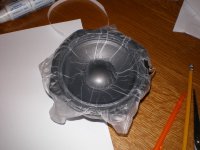 parafilm cover.jpg130.6 KB · Views: 1,056
parafilm cover.jpg130.6 KB · Views: 1,056 -
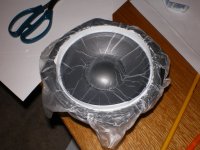 resin dam.jpg137.2 KB · Views: 1,051
resin dam.jpg137.2 KB · Views: 1,051 -
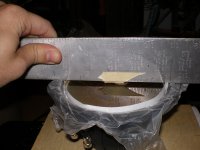 checking pour volume.jpg117.3 KB · Views: 1,043
checking pour volume.jpg117.3 KB · Views: 1,043 -
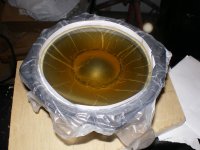 done pouring resin.jpg128.3 KB · Views: 1,038
done pouring resin.jpg128.3 KB · Views: 1,038 -
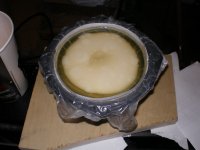 resin setting up.jpg92.9 KB · Views: 965
resin setting up.jpg92.9 KB · Views: 965 -
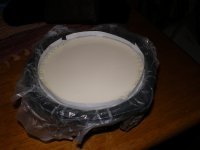 resin done setting.jpg84.2 KB · Views: 181
resin done setting.jpg84.2 KB · Views: 181 -
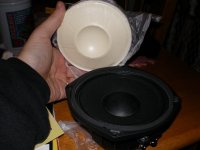 remove plug blank.jpg103.1 KB · Views: 209
remove plug blank.jpg103.1 KB · Views: 209
Wrong!
Following your assertions 1.)-10.) are my responses > ... :
Regards,
WHG
1.) I had it low passed at 800Hz 12dB/Oct.
> Too low. 1,000-2,000 Hz is recommended by the manufacturer. No wonder it sounded bad; the signal feed it is not even the bandwidth of a telephone.
2.) I had it high passed at 100Hz 24dB/Oct.
>Too low, the minimum is 200 Hz. Nasty output is expected under your conditions.
3.) They were tractrix horns with 4" throats to match the driver.
> Did the slopes of the driver and horn match at the throat connection point?
4.) They did not have honk or nasal tone.
> The tractrix curve is a near optimal contour for a horn; So, none is expected. The bell is fully formed as well; so, back-waves are minimized.
5.) Being loud and filling a room is entirely different than having correct tonal balance.
> The tonal balance is a measure of the marriage with other drivers outside the too-narrow, 100-800 Hz, range imposed; so it is a non-issue here. This driver is capable of filling a stadium with clean voice band signal. At lower in-room levels, its output signal is pristine. The artifacts of a too-small horn will change this.
6.) I built 11 slit radial phasing plugs for the cone drivers and they far exceeded the "performance" of the M4. I followed the guidelines in Clifford Henricksen's AES paper preprint no. 1328 (F-5)
> Bob Smiths circumferential slit phase plug design is superior [1] & [2]. It addresses the cancellation of radial modes that must occur when [Sd]>[St]. The claim here is suspect as well.
7.) The so called phasing plug of the M4 is crude at best.
>On what basis is in inferior? Because it is not a radial type?
8.) I tried the original diaphragms, the sandwich foam/aluminum ones, and the carbon fiber ones - they all stink.
>For the former design, I agree. For the later design, you are not using the driver properly. The "stink" is coming from elswhere!
9.) The M4 is a piece of garbage and anyone that thinks otherwise needs their hearing checked. Why are there so many available cheaply on the used market if they are so good?
>The assertion is patently fallacious. You do not have the information necessary to make the claim. How many are in the field? vs. How many used are for sale? In this case, one man's garbage may well be another's treasure.
10.) Goto is over priced and not a realistic option for the large majority of people.
> False! There are very few large format compression drivers from which to choose. So it remains the last, all be it, the most expensive alternative. Overpriced, no! High priced yes! The cost of the materials used here are expensive, they include Permendur pole pieces, Alnico magnets, and Beryllium diaphragms. So, some some naivety is being revealed here.
I Note that there is no comment for the JBL paper I referenced.
New References:
[1] File: ASAJ025-0305.PDF
Title: An Investigation of the Air Chamber of Horn Type Loudspeakers
Author: Bob H. Smith
Publication: ASA-J, Vol. 25, No. 2, Pg. 305-312, Mar-1953
Affiliation: Division of Electrical Engineering, University of California
URL: Cookies Required
Abstract (1): The front air chamber design is treated as a boundary value problem which yields a solution of the wave equation for the general case in which the horn throat enters the air chamber in a circumferentially symmetrical manner.
Abstract (2): The following specific cases are analyzed: (1) the case in which the horn throat enters the air chamber by means of a single orifice, (2) the horn throat enters the air chamber by means of a single annulus of radius [r] and width [w], and (3) the horn throat enters the air chamber in [m] annuli of radii [r1],[r2],...[rm] and widths [w1],[w2],...[wm].
Abstract (3): The analysis reveals that the radial perturbations caused by the horn throat excites higher order modes. At the resonant frequencies of these modes the horn throat pressure becomes zero and the loudspeaker does not radiate. By suitable choice of annulus radii and widths the first [m] modes may be suppressed and the corresponding nulls in the output pressure eliminated.
[2] File: AESJ057-0771.PDF
Title: New Methodology for the Acoustic Design of Compression Driver Phase Plugs with Concentric Annular Channels
Author: Mark Dodd
Affiliation: GP Acoustics, Ltd., Maidstone, UK
Author: Jack Oclee-Brown
Affiliation: GP Acoustics, Ltd., Maidstone, UK
Publication: AES-J, Vol. 57, No. 10 pp. 771-787 (Oct-2009)
URL: AES E-Library: New Methodology for the Acoustic Design of Compression Driver Phase Plugs with Concentric Annular Channels
Abstract: Compression drivers couple a radiating diaphragm to a horn throat of smaller area, resulting in high efficiency. Commonly a phase plug is used to control the transition from diaphragm to horn in order to improve the high-frequency performance. In this paper a new design method for the positioning of annular phase plug channels is presented in order to improve the driver response.
Following your assertions 1.)-10.) are my responses > ... :
Regards,
WHG
1.) I had it low passed at 800Hz 12dB/Oct.
> Too low. 1,000-2,000 Hz is recommended by the manufacturer. No wonder it sounded bad; the signal feed it is not even the bandwidth of a telephone.
2.) I had it high passed at 100Hz 24dB/Oct.
>Too low, the minimum is 200 Hz. Nasty output is expected under your conditions.
3.) They were tractrix horns with 4" throats to match the driver.
> Did the slopes of the driver and horn match at the throat connection point?
4.) They did not have honk or nasal tone.
> The tractrix curve is a near optimal contour for a horn; So, none is expected. The bell is fully formed as well; so, back-waves are minimized.
5.) Being loud and filling a room is entirely different than having correct tonal balance.
> The tonal balance is a measure of the marriage with other drivers outside the too-narrow, 100-800 Hz, range imposed; so it is a non-issue here. This driver is capable of filling a stadium with clean voice band signal. At lower in-room levels, its output signal is pristine. The artifacts of a too-small horn will change this.
6.) I built 11 slit radial phasing plugs for the cone drivers and they far exceeded the "performance" of the M4. I followed the guidelines in Clifford Henricksen's AES paper preprint no. 1328 (F-5)
> Bob Smiths circumferential slit phase plug design is superior [1] & [2]. It addresses the cancellation of radial modes that must occur when [Sd]>[St]. The claim here is suspect as well.
7.) The so called phasing plug of the M4 is crude at best.
>On what basis is in inferior? Because it is not a radial type?
8.) I tried the original diaphragms, the sandwich foam/aluminum ones, and the carbon fiber ones - they all stink.
>For the former design, I agree. For the later design, you are not using the driver properly. The "stink" is coming from elswhere!
9.) The M4 is a piece of garbage and anyone that thinks otherwise needs their hearing checked. Why are there so many available cheaply on the used market if they are so good?
>The assertion is patently fallacious. You do not have the information necessary to make the claim. How many are in the field? vs. How many used are for sale? In this case, one man's garbage may well be another's treasure.
10.) Goto is over priced and not a realistic option for the large majority of people.
> False! There are very few large format compression drivers from which to choose. So it remains the last, all be it, the most expensive alternative. Overpriced, no! High priced yes! The cost of the materials used here are expensive, they include Permendur pole pieces, Alnico magnets, and Beryllium diaphragms. So, some some naivety is being revealed here.
I Note that there is no comment for the JBL paper I referenced.
New References:
[1] File: ASAJ025-0305.PDF
Title: An Investigation of the Air Chamber of Horn Type Loudspeakers
Author: Bob H. Smith
Publication: ASA-J, Vol. 25, No. 2, Pg. 305-312, Mar-1953
Affiliation: Division of Electrical Engineering, University of California
URL: Cookies Required
Abstract (1): The front air chamber design is treated as a boundary value problem which yields a solution of the wave equation for the general case in which the horn throat enters the air chamber in a circumferentially symmetrical manner.
Abstract (2): The following specific cases are analyzed: (1) the case in which the horn throat enters the air chamber by means of a single orifice, (2) the horn throat enters the air chamber by means of a single annulus of radius [r] and width [w], and (3) the horn throat enters the air chamber in [m] annuli of radii [r1],[r2],...[rm] and widths [w1],[w2],...[wm].
Abstract (3): The analysis reveals that the radial perturbations caused by the horn throat excites higher order modes. At the resonant frequencies of these modes the horn throat pressure becomes zero and the loudspeaker does not radiate. By suitable choice of annulus radii and widths the first [m] modes may be suppressed and the corresponding nulls in the output pressure eliminated.
[2] File: AESJ057-0771.PDF
Title: New Methodology for the Acoustic Design of Compression Driver Phase Plugs with Concentric Annular Channels
Author: Mark Dodd
Affiliation: GP Acoustics, Ltd., Maidstone, UK
Author: Jack Oclee-Brown
Affiliation: GP Acoustics, Ltd., Maidstone, UK
Publication: AES-J, Vol. 57, No. 10 pp. 771-787 (Oct-2009)
URL: AES E-Library: New Methodology for the Acoustic Design of Compression Driver Phase Plugs with Concentric Annular Channels
Abstract: Compression drivers couple a radiating diaphragm to a horn throat of smaller area, resulting in high efficiency. Commonly a phase plug is used to control the transition from diaphragm to horn in order to improve the high-frequency performance. In this paper a new design method for the positioning of annular phase plug channels is presented in order to improve the driver response.
No experiences yet, but this new 5"er could fit the bill.
http://www.ciare.com/pdf/catalogo/PM135ND.PDF
http://www.ciare.com/pdf/catalogo/PM135ND.PDF
Hello,
As for the latest version of Marco Henry's "La Grande castine", the 300-3000Hz frequency range reproduced thorugh the largest round horn is (most probably) mounted on a 2" B&C compression drivers.
see:
High Efficiency Speaker Asylum - RE: La Grande Castine - Jmmlc - July 01, 2010 at 09:07:32
On the previous version a Radian 950 was used.
Best regards from Paris, France
Jean-Michel Le Cléac'h
hello Jean-Michel
do you know the reason, they switched the Radian for a B & C ?
- Status
- This old topic is closed. If you want to reopen this topic, contact a moderator using the "Report Post" button.
- Home
- Loudspeakers
- Multi-Way
- Driver for AH-160hz horn: cd vs cone?